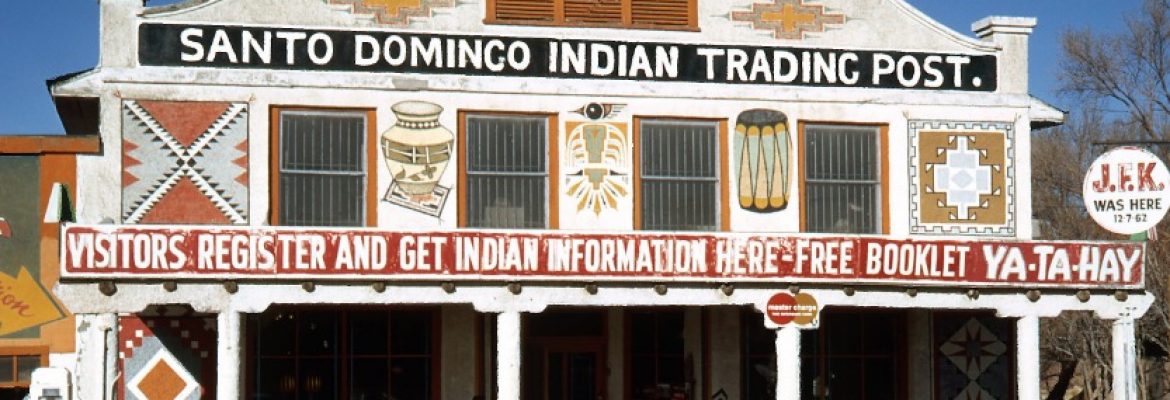Pueblo of Santo Domingo (Kewa Pueblo), Santo Domingo, New Mexico, USA
Called Kewa (Khe-wa) in the native Keresan language of its inhabitants, and previously known as the Pueblo of Santo Domingo, this traditional pueblo is located on the Rio Grande between Albuquerque and Santa Fe. Its people have a rich local culture that has not been overwhelmed by the outside influences brought to the area by Spanish colonization, the railroad in the 19th century, and Route 66 in the 20th century. Residents of the pueblo maintain their traditional religious practices and social structure. The pueblo has a long history of producing, trading, and selling crafts, especially jewelry and pottery. Visitors to the pueblo can still observe the traditional way of life there and attend ceremonial events, such as the internationally famous corn dance held every year on August 4.
Upon the arrival of Spanish explorers and colonizers in the summer of 1598, many pueblo people initially aligned themselves with the Spanish as means of combating Apache and Comanche raiders. The Spaniards quickly designated Santo Domingo a provincial capital, and, by 1610, the pueblo was a headquarters in the Spanish colonial mission system. Because the alliance failed to stop the raiding and the Spanish proved oppressive, Santo Domingo became a staging area for Pueblo resistance to Spanish rule late in the 17th century. After the Spanish quelled the uprisings in 1700, violent interaction between the Spanish and Pueblo residents began to cease.
Major floods from the Rio Grande in the late 1600s and 1886 were so destructive that residents had to rebuild the pueblo. Originally constructed around a central plaza, the pueblo, which residents rebuilt after the flood in 1886, has long blocks of adobe houses along a wide central street. Builders incorporated surviving structures into the new plan and extended the pueblo to the east. Two large kivas (circular rooms used for religious purposes) are within the pueblo, and a mission-style church from 1890 is located on the edge of the pueblo, a legacy of Spanish cultural influence.
Agriculture has long been a central part of Pueblo life. Farming shaped local culture, and the indigenous religious system of Santo Domingo Pueblo stresses agricultural rhythms and products. The local belief system strives for balance not only between people but also between people and the cosmos. Group ritual knowledge and ceremonies are integral to achieving this balance. Key religious figures are Kachinas, entities who bridge the cosmic and worldly realms and bring rain to help produce crops. A February hunting dance and an August corn dance reflect the poles of the agricultural year. The Corn Dance, a very popular local tradition, is also part of the Pueblo’s railroad and Route 66 history, as the dance is a cornerstone of the Santa Fe Fiesta, an event created and promoted during the time when tourism first became such a force in the Pueblo.
Once the area became part of the United States, the pueblo and its residents experienced new cultural influences, largely due to the pueblo’s location along the major transportation arteries of the Atcheson, Topeka, and Santa Fe Railroad in the 1880s and Route 66 in the 20th century. Railroad boosters and entrepreneurs promoted Pueblo people and crafts to 19th-century tourists via a stop at nearby Domingo Station. Many automobile tourists visited Santo Domingo Pueblo in the mid-1920s, after the completion of Route 66. Along the highway, tourists and Pueblo residents bought and sold crafts, particularly pottery and jewelry made for the tourist trade. Befitting the traditional culture of the Pueblo of Santo Domingo, the pottery reflects ancient crafting techniques. Roadside stands offer travelers different types of pueblo crafts.
The National Park Service listed Santo Domingo Pueblo in the National Register of Historic Places in 1973. In addition to the pueblo itself, a museum and cultural center provide opportunities to learn more about the area and its inhabitants. The Santo Domingo Pueblo (now Kewa Pueblo) is located approximately 35 miles north of Albuquerque and 25 miles south of Santa Fe, NM, via the Santo Domingo exit on Interstate 25. For more information, call 505-465-2214


